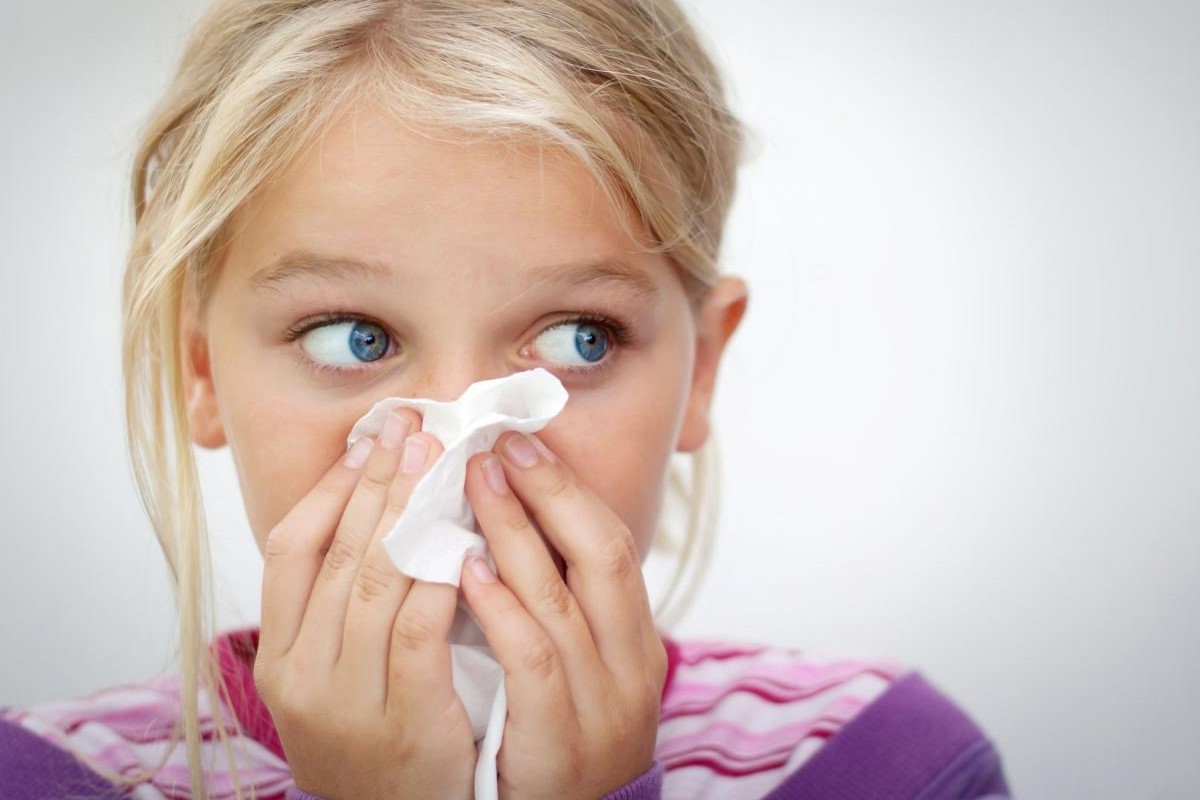
Paediatric seasonal illnesses: acute infectious rhinitis
Acute infectious rhinitis is an infection of the mucous membranes of the nose, which is very common, especially in children
It heals by itself and, in the vast majority of cases, does not benefit from antibiotic therapy.
Acute infectious rhinitis is an infection affecting the mucous membranes of the nose
It is characterised by nasal obstruction, profuse discharge of mucous material from the nasal cavities (rhinorrhoea) and sneezing.
The term ‘acute’ refers to the duration of the infectious process, which manifests and resolves within about 7-10 days, and the intensity of the symptoms, which are usually quite noticeable.
The microbes most frequently involved are viruses, which cause about 98% of cases in children, but less frequently acute rhinitis can also be caused by bacteria.
Among the viruses most frequently implicated in the infectious process are Rhinoviruses, Coronaviruses, influenza viruses, Adenoviruses, parainfluenza viruses, Sincizial Respiratory Virus, Enteroviruses, Metapneumoviruses.
Bacteria may include Streptococcus pneumoniae, Haemophilus influenzae and Moraxella catarrhalis.
Bacteria may be the cause of the initial infection or they may take over from a viral infection, creating an overinfection.
The microbe comes into contact with the mucous membranes of the nasal cavities, causing inflammation and thus swelling of the mucous membrane with abnormal accumulation of fluid (oedema) and dilation of the blood vessels (cause of nasal obstruction and profuse discharge of mucous material).
Inflammation also leads to the release of a number of inflammatory mediators causing sneezing.
CHILD HEALTH: LEARN MORE ABOUT MEDICHILD BY VISITING THE BOOTH AT EMERGENCY EXPO
Acute infectious rhinitis can occur in isolated form, but more commonly it is found in association with other symptoms such as:
- Headache;
- Fever;
- Sense of malaise;
- Sore throat;
- Cough.
In these cases the microbe has caused a more extensive infection of the airways, as occurs in the common cold.
Acute rhinitis can also be complicated by involvement of the paranasal sinuses, natural cavities located in the bones of the face that surround the nose, eyes and cheeks.
Involvement of the paranasal sinuses occurs mainly in bacterial infections, leading to a rhinosinusitis picture with:
- Headache;
- Pain on palpation at the paranasal sinuses;
- Altered sense of smell;
- Coughing;
- Abundant discharge of purulent material both from the nasal cavities and “down the throat” (into the pharynx).
In addition to sinusitis, acute infectious rhinitis – especially if caused by bacteria – can complicate with:
- Otitis media;
- Sore throat or pharyngotonsillitis.
- Diagnosis is generally based on a history of symptoms and an examination of the child.
As this is an infection that usually heals on its own, microbiological investigations are not routinely carried out to identify the germ that caused the infection.
In special cases, however, a nasopharyngeal swab or nasopharyngeal aspirate can be performed to identify the virus involved using classical microbiology or, more often, molecular medicine methods.
In cases where a bacterial cause is suspected, culture of the swab or aspirate is generally not useful as the bacteria causing rhinitis are often found even in healthy individuals as they are part of the normal bacterial flora of the nasal mucosa.
Treatment of acute infectious rhinitis is mainly symptomatic – i.e. aimed at symptom control – if a viral cause is suspected or confirmed.
Antibiotics are needed when the germ causing the rhinitis is a bacterium, especially if it is causing complications.
Antibiotics should always be prescribed by the paediatrician.
Acute infectious rhinitis is almost always caused by viruses and does not benefit from antibiotic therapy
On the other hand, it is also one of the main causes of inappropriate use of antibiotics, hence the phenomenon of antibiotic resistance, which today is increasingly undermining the effectiveness of these often life-saving drugs.
Nasal obstruction can be improved by performing nasal washes with saline or hypertonic solution.
Fever and sore throat can benefit from the use of an antipyretic and an anti-inflammatory.
Since it is mostly caused by germs that are transmitted by air, prevention is based first of all on avoiding close contact with people with acute infectious rhinitis or airway infections.
It is certainly helpful:
- Encourage your child to wash their hands often and not to touch their mouth, eyes or nose;
- Do not use shared objects;
- Clean and wash surfaces and toys used by several children;
- Ventilate enclosed spaces.
It is also important to have the legal vaccinations for some of the germs involved, especially to avoid complications due to more significant airway involvement.
Vaccination for the influenza virus is also indicated in some children.
Read Also
Emergency Live Even More…Live: Download The New Free App Of Your Newspaper For IOS And Android
Respiratory Allergies: Symptoms And Treatment
RSV (Respiratory Syncytial Virus) Surge Serves As Reminder For Proper Airway Management In Children
Acute And Chronic Sinusitis: Symptoms And Remedies
Symptoms And Remedies Of Allergic Rhinitis
Respiratory Or Food Allergies: What Is The Prick Test And What Is It For?
Anaphylactic Shock: What It Is And How To Deal With It
Sinusitis: How To Recognise That Headache Coming From The Nose
Sinusitis: How To Recognise And Treat It
Flu Vaccine For Children? Paediatricians: ‘Do It Now, Epidemic Already Started’
Rhinitis, Inflammation Of The Nasal Mucous Membranes


